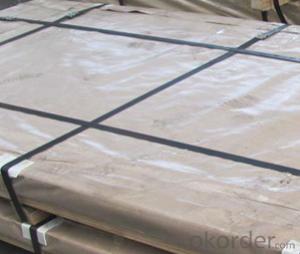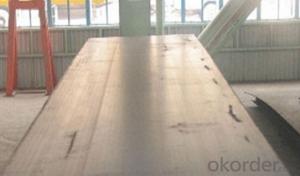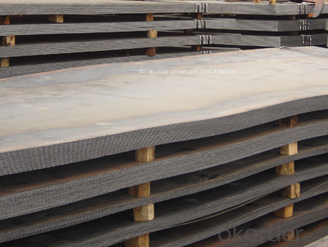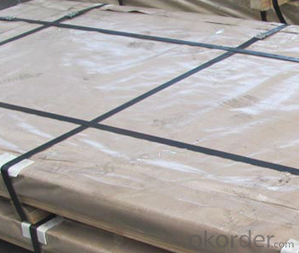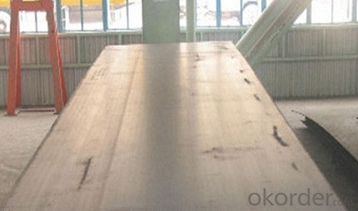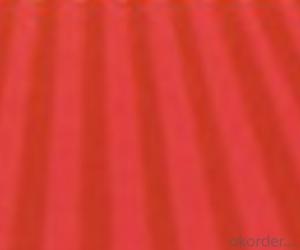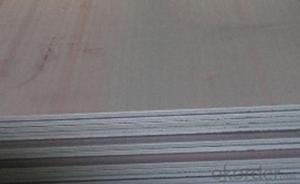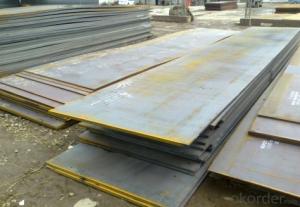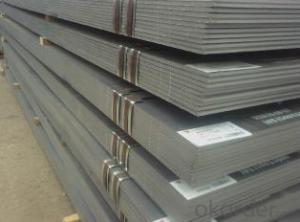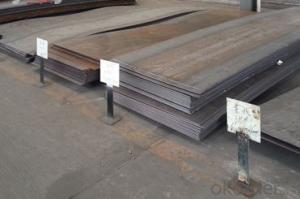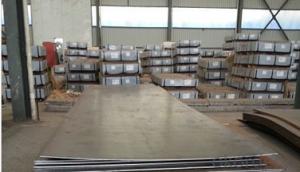Hot Rolled Carbon Steel Sheet G3101 CNBM
- Loading Port:
- Qingdao
- Payment Terms:
- TT OR LC
- Min Order Qty:
- 10 pc
- Supply Capability:
- 30 pc/month
OKorder Service Pledge
Quality Product, Order Online Tracking, Timely Delivery
OKorder Financial Service
Credit Rating, Credit Services, Credit Purchasing
You Might Also Like
Quick Details
| Standard: | AISI, ASTM, DIN, GB, JIS | Grade: | A572,A573,A633,A678,A709,A710,G3101,G3136,etc | Thickness: | 1mm-200mm |
| Brand Name: | SHOU GANG GROUP, AN STEEL | Model Number: | Q235 | ||
| Type: | Steel Plate | Technique: | Hot Rolled | Surface Treatment: | Coated |
| Application: | widely | Special Use: | High-strength Steel Plate | Width: | 1000mm-3000mm |
| Length: | 1000mm-12000mm | Price Term: | FOB CIF CFR |
Packaging & Delivery
| Packaging Details: | standard seaworthy export packing or as the request of customers |
| Delivery Detail: | 10 days after deposit or according to customers' quantity |
Specifications
hot rolled carbon steel sheet
1.Thickness:1mm-200mm
2.Length:1000mm-12000mm
3.Width:1000mm-2000mm
hot rolled carbon steel sheet
| Product | HR steel plate prices carbon steel plate prices per kg |
| MOQ | 25 ton |
| Thickness | 1mm-200mm |
| Width | 1000mm-3000mm |
| Length | 1000mm-12000mm |
| Application | widely |
| Standard | AISI,ASTM,BS,DIN,JIS,GB,etc |
| Grade | A572,A573,A633,A678,A709,A710,G3101,G3136,etc |
| Tpye | Steel plate |
| Surfacing | Coated |
| Productive Technology | Hot Rolled & Cold Rolled |
| Port | |
| Payment Terms | L/C,T/T,Western Union,MoneyGram |
| Product Ability | 5000 tons per month |
| Delivery | 10 days after deposit or according to customers' quantity |
| Packing | standard seaworthy export packing or as the request of customers |
- Q: Are steel sheets suitable for railway or transportation infrastructure?
- Yes, steel sheets are suitable for railway or transportation infrastructure. Steel is a strong and durable material that can withstand heavy loads and extreme weather conditions, making it ideal for constructing railway tracks, bridges, and transportation structures. Additionally, steel sheets can be easily fabricated, allowing for efficient construction and maintenance of transportation infrastructure.
- Q: What is the thickness of the steel sheets?
- The thickness of the steel sheets is typically measured in millimeters or gauge, and it can vary depending on the specific application or industry standards.
- Q: How do steel sheets perform in high-temperature environments?
- Steel sheets perform well in high-temperature environments due to their high melting point and excellent heat resistance. They retain their strength and structural integrity, making them suitable for various applications such as furnace linings, heat exchangers, and industrial ovens. However, prolonged exposure to extremely high temperatures can cause some degradation, such as oxidation or loss of mechanical properties, so appropriate alloying and protective coatings may be necessary for optimal performance.
- Q: How is the weight of the steel plate calculated?
- Steel plate is made of molten steel, cooled and compressed into flat steel.The steel plate is flat, rectangular, and can be rolled directly or cut from a wide strip of steel.
- Q: Are the steel sheets suitable for food-grade applications?
- Yes, steel sheets can be suitable for food-grade applications. Stainless steel in particular is commonly used in the food industry due to its excellent corrosion resistance, durability, and ease of cleaning. It is non-reactive and does not release any harmful substances into food, making it a safe choice for food storage, processing, and transportation. Additionally, stainless steel is resistant to high temperatures and can withstand rigorous cleaning and sanitization processes, making it ideal for use in food-grade applications. However, it is important to ensure that the steel sheets meet the necessary food-grade standards and regulations before using them in any food-related setting.
- Q: How do steel sheets perform in terms of electrical resistance?
- Compared to other materials, steel sheets exhibit a comparatively higher electrical resistance. Consequently, their conductivity falls short in comparison to metals such as copper or aluminum. The electrical resistance of steel sheets may fluctuate depending on variables like the sheet's composition and thickness. Generally speaking, steel sheets are regarded as inadequate conductors of electricity. Nevertheless, it is crucial to acknowledge that the application of specific coatings or treatments to the steel surface can diminish the electrical resistance.
- Q: Can steel sheets be used for outdoor sculptures or artwork?
- Yes, steel sheets can be used for outdoor sculptures or artwork. Steel is a durable material that can withstand outdoor conditions and can be shaped and welded into various artistic forms. Its strength and resistance to corrosion make it suitable for outdoor installations, allowing for the creation of long-lasting and visually appealing sculptures and artwork.
- Q: Are steel sheets suitable for oil rig platforms?
- Yes, steel sheets are suitable for oil rig platforms. Steel is widely used in the construction of oil rig platforms due to its exceptional strength and durability. Oil rig platforms are subjected to harsh environmental conditions, such as extreme temperatures, high winds, and corrosive saltwater, and steel has proven to be able to withstand these conditions effectively. Steel sheets provide a strong and stable foundation for the oil rig platforms, ensuring that they can support the weight of the rig, equipment, and personnel. The high strength of steel allows for the construction of large and complex structures while maintaining stability and safety. Furthermore, steel is highly resistant to corrosion, making it an ideal material for offshore applications. The oil rig platforms are constantly exposed to saltwater, which can cause corrosion and weaken other materials. Steel sheets, however, can be specially treated with protective coatings to enhance their resistance to corrosion and extend their lifespan. In addition to its strength and corrosion resistance, steel is also a versatile material that can be easily shaped and fabricated into various components required for oil rig platforms. This flexibility allows for efficient and cost-effective construction processes, reducing both time and resources required for installation and maintenance. Overall, steel sheets are a suitable choice for oil rig platforms due to their strength, durability, corrosion resistance, and versatility. They provide a reliable and robust foundation for offshore drilling operations, ensuring the safety and longevity of the platform in challenging environments.
- Q: What are the different certification standards for steel sheets?
- There are several certification standards that exist for steel sheets, each with their own specific requirements and criteria. Some of the most commonly recognized certification standards for steel sheets include: 1. ASTM International: ASTM A1008/A1008M is a standard specification for cold-rolled, carbon steel sheets. This certification standard ensures that the steel sheets meet specific mechanical properties, chemical composition, and dimensional requirements. 2. American Society of Mechanical Engineers (ASME): ASME SA240 is a specification for chromium and chromium-nickel stainless steel plate, sheet, and strip for pressure vessels and general applications. This certification standard ensures the quality and safety of stainless steel sheets used in various industrial applications. 3. International Organization for Standardization (ISO): ISO 3574 is a standard specification for cold-reduced carbon steel sheet of commercial and drawing qualities. ISO 3574 certification ensures that the steel sheets have specific mechanical properties, surface finish, and dimensions. 4. European Committee for Standardization (CEN): EN 10025 is a European standard for hot-rolled structural steel products. This certification standard covers various grades and dimensions of steel sheets used in construction and engineering applications. 5. Japanese Industrial Standards (JIS): JIS G 3141 is a Japanese standard for cold-reduced carbon steel sheets and strips. This certification standard ensures that the steel sheets meet specific mechanical properties, chemical composition, and dimensional requirements. These are just a few examples of the certification standards available for steel sheets. Depending on the intended application and geographical location, there may be additional regional or industry-specific certification standards that need to be met to ensure the quality and suitability of the steel sheets.
- Q: What are the different cutting methods for steel sheets?
- There are several cutting methods commonly used for steel sheets, including shearing, laser cutting, plasma cutting, waterjet cutting, and abrasive cutting. Each method has its own advantages and suitability depending on the thickness and type of steel, desired precision, speed, and cost considerations.
Send your message to us
Hot Rolled Carbon Steel Sheet G3101 CNBM
- Loading Port:
- Qingdao
- Payment Terms:
- TT OR LC
- Min Order Qty:
- 10 pc
- Supply Capability:
- 30 pc/month
OKorder Service Pledge
Quality Product, Order Online Tracking, Timely Delivery
OKorder Financial Service
Credit Rating, Credit Services, Credit Purchasing
Similar products
Hot products
Hot Searches
Related keywords

